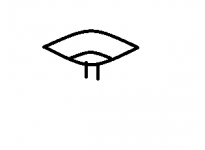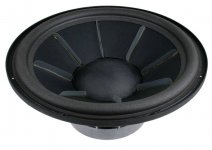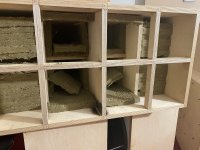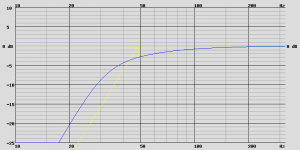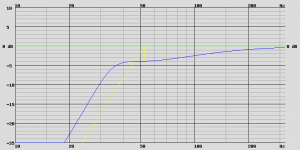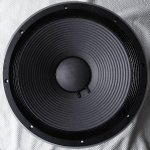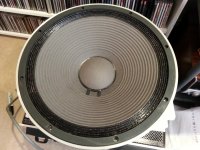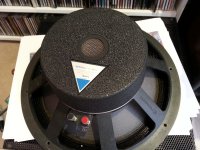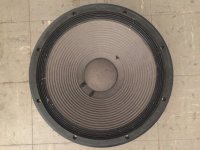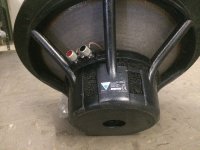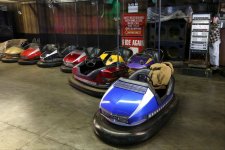Hi phase-accurate,
indeed this would be worth finding out.
I guess that the loss in impulse is viable for higher frequencies. I assume that putting two saucers together forming a strong elliptical form is quite stiff for lower frequencies.
Dustcaps can also be somewhere in between outer edge and voice coil diameter.
I always liked the Radiotehnika GDN 75 for his big stiffening dustcap
indeed this would be worth finding out.
I guess that the loss in impulse is viable for higher frequencies. I assume that putting two saucers together forming a strong elliptical form is quite stiff for lower frequencies.
Dustcaps can also be somewhere in between outer edge and voice coil diameter.
I always liked the Radiotehnika GDN 75 for his big stiffening dustcap
Attachments
Last edited:
I really appreciate the use of beryllium for TAD high frequency drivers.
What i wonder is why they just use simple paper diaphragms for the bass drivers.
As far as I know paper has not enough stiffness for a really good sound reproduction - especially big drivers suffer from bending forces in the diaphragm.
If they would have very big dustcaps this would bring lots of stability like with a 13cm paper diaphragm bass driver I tweaked with a big paper dustcap for getting true piston motion.
This post gets to the heart of my understanding of TAD, and Beryllium in general.
When listening to speakers with Beryllium tweeters (horn loaded or dome) I oftentimes get a slight headache after a while.
It's like watching 4k TV/cinema which is too sharp, the soap opera effect.
The sublime properties of Beryllium stand out, making the midrange and treble very pronounced compared to the low mids and bass. To be honest, I usually prefer tweeters that better match the cones in terms of decay. This creates a more homogeneous and pleasant sound field.
Today there are plenty of drivers available at a fraction of the price of TAD drivers, that may not be quite as good, but good enough...
And how many of these drivers are optimized to be used in a two way loudspeaker system, capable to reproduce from 30Hz to 600-700Hz, at SPL levels up to 120dB ?

I really appreciate the use of beryllium for TAD high frequency drivers.
What i wonder is why they just use simple paper diaphragms for the bass drivers.
As far as I know paper has not enough stiffness for a really good sound reproduction - especially big drivers suffer from bending forces in the diaphragm.
If they would have very big dustcaps this would bring lots of stability like with a 13cm paper diaphragm bass driver I tweaked with a big paper dustcap for getting true piston motion.
Your driver is similar to the inverse cone drivers Avantgarde uses for the mid horns.
Paper has been by far the most widely used material for cones since the pioneers, and for good reason.
Much research has been done on the almost infinite amount of interdependent factors that affect the working of cone drivers.
A quote:
"Frankfort, also seeking solutions for the membrane vibrations of conical loudspeaker cones, formulated a differential equation that accounts for
bending vibration and made detailed calculations of the sound pressure frequency response, vibration patterns, and driving-point admittance. However, Frankfort’s analysis did not account for the effects of the edge and center cap, which play important roles in cone loudspeakers. Subsequently, the finite element method (FEM) has been used for vibration analysis of the cone. Kyouno et al. analyzed the sound radiation from loudspeakers, accounting for coupling of the electrical, mechanical, and acoustic systems.
In these vibration analyses of cone loudspeakers, the cone maintains a piston motion in the low-frequency region. The biggest difficult point of these analyses is the split vibration of the vibration plate in the middle- and high-frequency regions. Control over the cone and the edge is very important
in the design of a loudspeaker."
In other words: cone drivers are subject to all kinds of disturbances and there is no such thing as a perfect cone driver. The Purifi woofers probably come closest to optimal and, lo and behold, the used cone material is "Proprietary Fibre Mix", what I translate with "advanced paper pulp".
Even though I consider myself an elementarist, the world looks better to me with a slight clouding (at a distance). Call it a somewhat romanticized reflection of clinical reality.
The same goes for casual listening to music - which is obviously different from producing or mixing music.
Wrt the former, homogeneity in the rendering is in my opinion more important than absolute precision/linearity etc.
As I have stated many times, in my view efficiency (η₀) is a determining factor.
The moment the pursuit of perfect lab results gains the upper hand, efficiency often loses out.
Ever listened to Magico loudspeakers?
They may be very good, though far from "Magical", if you ask me.
Attachments
-
 trio-lowmid.jpg99.5 KB · Views: 281
trio-lowmid.jpg99.5 KB · Views: 281 -
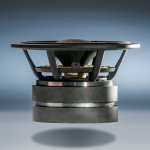 1e399e9b-1b38c885-avantgarde-uno-xd-midrange-driver.jpg69.3 KB · Views: 294
1e399e9b-1b38c885-avantgarde-uno-xd-midrange-driver.jpg69.3 KB · Views: 294 -
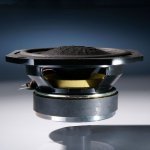 02d80641-529d9a11-avantgarde-zero-1-xd-midrange-driver.jpg66.1 KB · Views: 183
02d80641-529d9a11-avantgarde-zero-1-xd-midrange-driver.jpg66.1 KB · Views: 183 -
 strip7.jpg48.4 KB · Views: 173
strip7.jpg48.4 KB · Views: 173 -
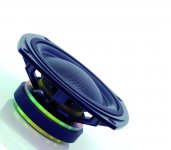 trio-g2_mid.jpg127.4 KB · Views: 180
trio-g2_mid.jpg127.4 KB · Views: 180 -
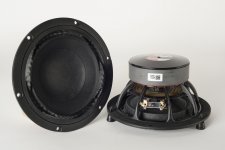 PTT6.5W04_1200_B.jpg191 KB · Views: 164
PTT6.5W04_1200_B.jpg191 KB · Views: 164
Last edited:
Like Acoustic Elegance you mean Djimitrij-S?
Tad designs are almost 40 years old now, world economic situation and market changed too.
Tad are not the only ones to drop off 'high end' drivers ( at least in France): Davis seems to have dropped the Carbon 12" and 15" ( used in Rey audio/Kinoshita's Warp line, the 15" were credible alternative to TAD drivers ( i even prefered the carbon Davis for my own preferences)), PHL changed owner and there is uncertainty about future, Audax seems frozen...
But it seems to be the same not only in EU: Volts drivers seems to had huge increase in prices ( because of Brexit?).
Only some dedicated small company seems to be interested in this 'special' designs.
That said overall PA drivers offers have gone up in quality ( global) and there is interesting drivers availlable from B&C, Bms, Faital,....
Tad designs are almost 40 years old now, world economic situation and market changed too.
Tad are not the only ones to drop off 'high end' drivers ( at least in France): Davis seems to have dropped the Carbon 12" and 15" ( used in Rey audio/Kinoshita's Warp line, the 15" were credible alternative to TAD drivers ( i even prefered the carbon Davis for my own preferences)), PHL changed owner and there is uncertainty about future, Audax seems frozen...
But it seems to be the same not only in EU: Volts drivers seems to had huge increase in prices ( because of Brexit?).
Only some dedicated small company seems to be interested in this 'special' designs.
That said overall PA drivers offers have gone up in quality ( global) and there is interesting drivers availlable from B&C, Bms, Faital,....
Last edited:
...What i wonder is why they just use simple paper diaphragms for the bass drivers.
I had a chance to examine a broken membrane from TAD 1601 driver, according to my observations, the membrane was not quite simple paper, but covered with some kind of hard polymer coating (like Aquaplas 😕). The membrane seemed quite stiff.
How much of these diaphragm modes affect midrange btw?
Isobaric still intrigues me. I dont know exactly how much but I am in the understanding that isobaric config "increases" diaphragm rigidity very well.... I don't know if I should say that it increases the rigidity, or that it alleviates the pressures that would be challenging the rigidity... either way it supposedly works out.

I've got the mid range enclosures almost zipped up...I was hoping to make a little more progress but cutting up the insulation took more time than I anticipated...I am now considering how much damping material to put into the bass bins...I figured that since I intend to use them as high as possible, with that possibility being near 150hz, Damping material would be in order, no less, than the upper bass box, I suppose.
Isobaric still intrigues me. I dont know exactly how much but I am in the understanding that isobaric config "increases" diaphragm rigidity very well.... I don't know if I should say that it increases the rigidity, or that it alleviates the pressures that would be challenging the rigidity... either way it supposedly works out.
I've got the mid range enclosures almost zipped up...I was hoping to make a little more progress but cutting up the insulation took more time than I anticipated...I am now considering how much damping material to put into the bass bins...I figured that since I intend to use them as high as possible, with that possibility being near 150hz, Damping material would be in order, no less, than the upper bass box, I suppose.
Attachments
Last edited:
ATC, Geithain and some other small companies still make "healthy but not boring" sounding large monitor speakers, but it's sad to see very small market left for large studio monitors and large home speakers these days. It would be true that all R&D money go to sound reinforcement devision...
And how many of these drivers are optimized to be used in a two way loudspeaker system, capable to reproduce from 30Hz to 600-700Hz, at SPL levels up to 120dB ?
2 Examples that come close:
- BMS 15S330
- RCF L15P400
Attachments
I had a chance to examine a broken membrane from TAD 1601 driver, according to my observations, the membrane was not quite simple paper, but covered with some kind of hard polymer coating (like Aquaplas 😕). The membrane seemed quite stiff.
Was it a TL-1601A, B or C?
Attachments
Comment by the late Scott Fitlin that almost exclusively used TAD drivers in his Colorado Bumper Car Disco (Coney Island):
"TAD 1601A- accordian surround, alnico magnet, Fs 28Hz, 300w power handling, 97DB 1w@1m 900hz or lower crossover recommended.
TAD 1601B= accordian SURROUND, alnico magnet, Fs 28Hz, ventilated VC former, 500w power handling, 97.5DB 1w@1m. 900hz crossover or lower recommended.
TAD 1601C- accordian surround, alnico magnet, Fs 28Hz, triangular metal weight to counterbalance against lead weight, 97DB 1w@1M, 500w power handling, was $995 list, now discontinued.
TAD 1602- Foam surround, treated cone, high compliance suspension, 21Hz Fs, alnico magnet, 300w max power handling, similar to JBL 2235.
TAD 1603- accordian surround, ceramic magnet, Fs 28Hz, 500w power handling, 97Db 1w@1m, 900hz or lower crossover recommended.
I have never heard the 1602, so I have no comments.
The 1601 A & B, and 1603 I know well. 1601A is clean, smooth, big deep low end, flat response. 1601B takes more power, and is also an excellent sounding woofer. The 1601A and B sounds great, but PRICEY, alnico costs.
The 1603, I use them, and know others who use this model as well. Deep, heavy, big thump, smooth low mid, very clean, purrs on low notes, handles a great deal of power, very durable, and produces a large amount of low end. I have them horn loaded in my Altec cabinets, and they produce, definitely deeper and smoother sounding to my ears than the JBL 2226. Real drums sound phenomenal through these, as well as bass guitar and keyboard notes and vocals.
I tried EVERYTHING, JBL 2226, TAD, 18Sound, B & C, EV, TAD was the best sounding to me. Low end is HUGE and clean, with a touch of warmth. Price just under $500.00ea. Works very well powered by BGW, Bryston, Crown, QSC, Crest, Lab or any other suitable high quality amplifier with proper power. TAD 1603,s THUMP, and have great low end definition, and are really reliable, they dont break.
I am comparing these to modern woofers, in production today, not vintage drivers, EVERY modern driver mentioned will outperform yesterdays drivers in terms of power handling, thermal compression, and reliabilty, in demanding use.
Sonically, TAD sounds great, JBL,ish, to a large degree, but deeper low end than the 2226H, and TAD paper cones are of great quality. TAD drivers are CLEAN, and play GREAT low end.
The JBL 2226 has more mid bass kick, but the TAD 1603 snaps, and is warmer and easier and fuller sounding. I tried B & C and JBL, 18Sound, The TAD won. What can I say?
1601A is even smoother, but, not as robust, the 1601B is robust, sounds great, but $775.00 or higher, list pr OUCH!
Basically, TAD is the Japanese answer to JBL, cost no object, super high quality designs. They are THAT good, but are very expensive, and hard to get. When TAD is out of stock, you just gotta wait."
"TAD 1601A- accordian surround, alnico magnet, Fs 28Hz, 300w power handling, 97DB 1w@1m 900hz or lower crossover recommended.
TAD 1601B= accordian SURROUND, alnico magnet, Fs 28Hz, ventilated VC former, 500w power handling, 97.5DB 1w@1m. 900hz crossover or lower recommended.
TAD 1601C- accordian surround, alnico magnet, Fs 28Hz, triangular metal weight to counterbalance against lead weight, 97DB 1w@1M, 500w power handling, was $995 list, now discontinued.
TAD 1602- Foam surround, treated cone, high compliance suspension, 21Hz Fs, alnico magnet, 300w max power handling, similar to JBL 2235.
TAD 1603- accordian surround, ceramic magnet, Fs 28Hz, 500w power handling, 97Db 1w@1m, 900hz or lower crossover recommended.
I have never heard the 1602, so I have no comments.
The 1601 A & B, and 1603 I know well. 1601A is clean, smooth, big deep low end, flat response. 1601B takes more power, and is also an excellent sounding woofer. The 1601A and B sounds great, but PRICEY, alnico costs.
The 1603, I use them, and know others who use this model as well. Deep, heavy, big thump, smooth low mid, very clean, purrs on low notes, handles a great deal of power, very durable, and produces a large amount of low end. I have them horn loaded in my Altec cabinets, and they produce, definitely deeper and smoother sounding to my ears than the JBL 2226. Real drums sound phenomenal through these, as well as bass guitar and keyboard notes and vocals.
I tried EVERYTHING, JBL 2226, TAD, 18Sound, B & C, EV, TAD was the best sounding to me. Low end is HUGE and clean, with a touch of warmth. Price just under $500.00ea. Works very well powered by BGW, Bryston, Crown, QSC, Crest, Lab or any other suitable high quality amplifier with proper power. TAD 1603,s THUMP, and have great low end definition, and are really reliable, they dont break.
I am comparing these to modern woofers, in production today, not vintage drivers, EVERY modern driver mentioned will outperform yesterdays drivers in terms of power handling, thermal compression, and reliabilty, in demanding use.
Sonically, TAD sounds great, JBL,ish, to a large degree, but deeper low end than the 2226H, and TAD paper cones are of great quality. TAD drivers are CLEAN, and play GREAT low end.
The JBL 2226 has more mid bass kick, but the TAD 1603 snaps, and is warmer and easier and fuller sounding. I tried B & C and JBL, 18Sound, The TAD won. What can I say?
1601A is even smoother, but, not as robust, the 1601B is robust, sounds great, but $775.00 or higher, list pr OUCH!
Basically, TAD is the Japanese answer to JBL, cost no object, super high quality designs. They are THAT good, but are very expensive, and hard to get. When TAD is out of stock, you just gotta wait."
Attachments
Last edited:
Was it a TL-1601A, B or C?
1601a
Here it is

Photo courtesy of my friend.
If you look closely, even in the photo you can see a layer of some kind of coating at the site of the cut.
Fs 28Hz, 300w power handling, 97DB 1w@1m 900hz or lower crossover recommended.
Where to find a 15" woofer with this mix of FS and efficiency (on a budget)? 😕
parts-express.com
Really? I don't seem to see ANY at PE that can meet that mix of spec.... 😕
Please do tell
Really? I don't seem to see ANY at PE that can meet that mix of spec.... 😕
Please do tell
Dayton Audio PN395-8 15" NEO Series Pro Woofer with 4" Voice Coil 8 Ohm
Driver fs, how big of a deal is that? Its not...for a vent...vent tuning is final say (not fs). Sealed box is limited by excursion as well, not driver fs...we typicaly aim for large sealed enclosures stuffed to the brim with damping material, deadening most resonance if possible...maybe the only connection of driver fs to something relevant is the weight of diaphragm suggesting a possibly rigid cone derived from materials that added weight coincidently. Or maybe the thought of keeping a resonate mode towards the bottom or out of the passband...either way the box + driver tuning takes precedence.
Driver fs, how big of a deal is that? Its not...for a vent...vent tuning is final say (not fs). Sealed box is limited by excursion as well, not driver fs...we typicaly aim for large sealed enclosures stuffed to the brim with damping material, deadening most resonance if possible...maybe the only connection of driver fs to something relevant is the weight of diaphragm suggesting a possibly rigid cone derived from materials that added weight coincidently. Or maybe the thought of keeping a resonate mode towards the bottom or out of the passband...either way the box + driver tuning takes precedence.
Last edited:
- Home
- Loudspeakers
- Multi-Way
- Is it possible to cover the whole spectrum, high SPL, low distortion with a 2-way?
